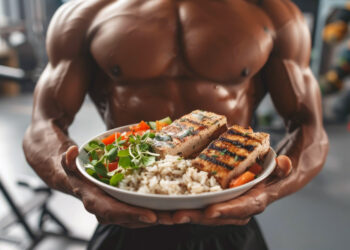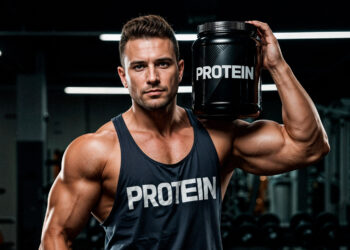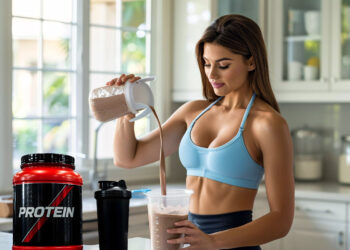Protein shakes are an integral part of most people’s fitness routines. The use of these magic powders is widespread. The sports nutrition market is flooded with protein powders. They come in different shapes, sizes, and flavors, use diverse ingredients, and promise varying results.
Since the best and highest-quality protein powders can cost you dearly, most folks constantly look for ways to make the most out of them. In this article, we’ll look at whether you should consume your protein shake right after a workout, spread your protein intake evenly throughout the day or switch to some other pattern for superior results.
One study examined whether providing 25 percent of protein at breakfast and lunch and the remaining 50 percent at dinner had any impact on nitrogen balance compared to spreading the protein evenly across the day’s three meals. The results were the same regardless of how the protein was distributed.
Recent studies have examined a dietary strategy called protein pulse feeding, which involves consuming 80 percent of the day’s protein at lunch, with 10 percent each at the other two meals. This strategy was compared to a more typical eating pattern where the day’s protein intake was distributed evenly across four meals. In elderly women, the pulse pattern led to a more significant protein gain than the spread pattern. There was a different result in younger women, however, as the spread pattern was superior, leading to a greater nitrogen balance.
When is the Best Time to Take Protein?
This is arguably the most common question among bodybuilding enthusiasts. As an athlete, you want to fine-tune every aspect of your routine to get the best results, including the timing of your protein intake.
Level Up Your Fitness: Join our 💪 strong community in Fitness Volt Newsletter. Get daily inspiration, expert-backed workouts, nutrition tips, the latest in strength sports, and the support you need to reach your goals. Subscribe for free!
You’ve probably heard about the “anabolic window” and how you must drink your protein shake within 30 minutes of your workout to get the best results. This is why most lifters keep their protein powder at arm’s length during their workout and chug it down as soon as they complete their final set.
However, recent research has shown that your overall daily protein intake plays a more significant role in maximizing hypertrophy than timing your protein intake. [1]
Your daily protein intake and timing can vary depending on your current physique and training objective. Here is the best time to take protein, depending on different training goals:
Weight Loss
The amount of protein you should consume in a day will depend on your daily calorie goal. People trying to lose weight should be in a caloric deficit, meaning they should burn more calories than they eat.
Folks trying to lose weight while building or retaining muscle mass should use a combination of the following macronutrient split ranges:
- Carbohydrates: 35% to 60%
- Protein: 30% to 45%
- Fats: 10% to 30%
Remember, a gram of carbohydrate and protein contains four calories each, and a gram of fat delivers nine calories. Get into the habit of reading food labels and counting calories to succeed in your body transformation journey. We recommend using a calorie-tracking app like MyFitnessPal.
Eating a high-protein, low-carb, and low-fat diet will help empty your stored glycogen reserves, aiding in burning body fat. Plus, the high-protein content will keep you satiated throughout the day.
To lose weight, you must focus on eating protein-rich foods in all your meals throughout the day to reduce your risk of eating junk food. Eat protein-rich snacks such as protein bars between meals if you are starving.
Building Muscle
Protein is the building block of muscle. You cannot expect to build muscle mass by limiting your protein intake.
The timing of protein intake after a workout is a hotly debated topic. While some people swear by consuming protein within 30 minutes of finishing their training session, others follow a much more relaxed approach.
According to research, the anabolic effect of exercise is long-lasting (at least 24 hours) but diminishes with increasing time post-exercise. [2]
Bodybuilders should consume protein within two hours after their workout for optimal muscle mass growth and recovery. Lifters trying to build muscle should consume a steady amount of protein throughout the day. However, protein intake should be slightly increased in their pre and post-workout meals for greater insulin sensitivity, which helps build and retain muscle mass. [3]
However, meeting the daily protein goal is more important for a hobbyist lifter than timing his protein intake.
Maintaining Muscle
Individuals trying to retain muscle mass will follow a similar protein intake approach to those trying to build muscle. Spread your protein intake evenly throughout the day to prevent muscle loss. Furthermore, bodybuilders should eat slightly more protein before and after their training sessions to boost muscle growth and prevent muscle breakdown.
A combination of slow proteins combined with evenly spaced meals keep blood amino acid levels stable throughout the day and are optimal for maintaining muscle mass and strength.
Boost Endurance
We have already discussed protein intake for bodybuilders and people trying to retain muscle mass. Now, it’s time to talk about folks who want to improve their physical endurance and stamina.
Besides protein, carbohydrate intake is crucial for endurance athletes. Endurance athletes should spread their protein and carb intake evenly throughout the day. However, they should consume slightly more carbs before and after their training sessions to replenish their glycogen reserves and avoid crashes.
Consuming carbs and protein before and after a workout can help improve performance and recovery and reduce muscle soreness.
Factors To Consider While Determining Protein Intake
You should consider the following factors while determining your daily protein intake:
Current Physique and Training Goal
Start by determining your average daily calorie intake. You must adjust your calorie intake depending on your training objective. Gaining muscle mass, maintaining muscle mass, or losing weight will all require different calorie and protein intake.
Folks trying to lose weight must enter a calorie deficit, whereas people trying to gain muscle mass should be in a calorie surplus.
The Centers for Disease Control and Prevention (CDC) recommends adding 500-1,000 to your daily calorie intake to gain 1-2 pounds weekly. Conversely, cutting the same amount from your daily diet can help you lose 1-2 pounds a week. [4]
Food Source
In the protein timing debate, the food source quality is often overlooked. Although protein supplements are incredibly convenient and effective, they shouldn’t be the primary source of protein in your diet. You should focus on high-quality protein sources like meat, fish, eggs, dairy products, grains, seeds, and legumes to meet your daily protein needs.
Frequency
Consuming very large amounts of protein all at once, as the protein pulse studies suggest, has an effect similar to a fast-absorbing protein such as whey. This spike of amino acids into the bloodstream promotes protein synthesis and oxidation.
When the protein is spread out in smaller amounts throughout the day, it has an effect closer to casein’s. Casein is very effective at inhibiting protein breakdown but with a smaller impact on protein synthesis.
Considering this information, it may be best to maintain relatively constant low levels of amino acids, with a spike around training, if you want to build or retain muscle mass and strength.
Level Up Your Fitness: Join our 💪 strong community in Fitness Volt Newsletter. Get daily inspiration, expert-backed workouts, nutrition tips, the latest in strength sports, and the support you need to reach your goals. Subscribe for free!
Also, people training in a fasted state should prioritize consuming protein shortly after their workout to kickstart protein synthesis and avoid entering a catabolic state where their body breaks down muscle to use as fuel.
Balance Your Type of Protein Intake
You must consume a combination of slow and fast protein sources at each meal for optimal muscle recovery and growth, as this would promote a spike in amino acids and stimulate protein synthesis, followed by a slower increase to inhibit protein breakdown.
Soy, beef, and cottage cheese are some examples of slow-digesting protein sources, whereas chicken breast and fish are a couple of fast-digesting proteins. Milk is a superfood in this regard, as it contains fast-digesting whey and slow-digesting casein.
Types of Proteins
Nutrient-dense whole foods such as meat, fish, eggs, dairy products, grains, seeds, and legumes should be your primary source of protein. Furthermore, you can utilize supplements to meet the protein deficiencies in your diet. Here are the most popular protein supplements:
Whey Protein
Whey protein powder is the most popular type of protein on the market. You could get it in two forms — isolate and concentrate. The isolate form has few carbs, fats, and calories than the whey concentrate form and is faster absorbing.
Casein Protein
Casein protein is a slow-digesting protein. It releases protein slowly over six to eight hours, ensuring your muscles have all the necessary nutrients to rebuild and repair. Because of its slow-digesting properties, most people prefer consuming casein protein before bed.
Egg Protein
Egg protein is absorbed faster than dairy protein supplements (whey and casein). It is best taken right after a training session. You’ll mostly find egg white protein supplements on the market, as including the yellow part significantly increases the fat content of the supp, throwing off their macronutrient balance.
Beef Protein
Beef protein powders have a cult following. They usually have higher-protein content, more gastrointestinal benefits, natural ingredients, and biological value than whey protein supplements. However, most people find them too dense to consume after a workout.
Plant-Based Protein
Thanks to the vegan movement, plant-based proteins have quickly become one of the most popular protein supplements on the market. Most plant-based protein supps contain multiple ingredients to deliver a complete amino acid profile. A protein supplement must have all nine essential amino acids (histidine, isoleucine, leucine, lysine, methionine, phenylalanine, threonine, tryptophan, and valine) to be deemed a complete protein. [5]
Many people believe that plant-based protein sources are incomplete. However, this is not entirely true. Here are the single-ingredient plant-based protein supps that are complete proteins:
Pea Protein
It is the most popular protein source in vegan proteins. Pea protein, unlike many other plant-based proteins, is a complete protein similar to meat, which is why you’ll generally find this ingredient plastered on the front of every multi-ingredient plant-based protein supp. Notably, pea protein contains low levels of the nonessential amino acids cysteine and methionine.
Soy Protein
It is another vegan protein source that contains all nine essential amino acids. Soy can help lower cholesterol and is recommended as a dietary substitute for higher-fat animal products. Some people can have difficulty digesting soy. However, most soy proteins contain digestive enzymes, making these supplements easy on your stomach.
Hemp Protein
Hemp protein contains all nine essential amino acids plus fiber, healthy fats, and minerals. Although hemp is technically a complete protein, it contains insignificant quantities of lysine. If you use a hemp protein supp, you must meet your daily lysine goals from other sources.
Rice Protein
We know what you are thinking — “Isn’t rice primarily a carb source?” Yes, it is. However, it contains all nine essential amino acids. That said, rice’s ‘complete protein’ tag is often criticized as, just like hemp protein, it lacks the essential amino acid lysine.
To avoid nutrient deficiencies and ensure overall health and well-being, vegans must be considerate of their EAA intake while taking a plant-based supplement. Supplementing a plant-based protein supp with an EAA supplement can help clog any nutrient voids in your diet.
A study compared two groups. The first received three whole-food meals, while the second received the same three meals with an essential amino acid (EAA) supplement in between those meals. The second group generated a more significant protein synthetic response than the whole-meal group. The EAA supplement group also generated an anabolic response, even when the supplement was given in-between meals. This means the previously consumed meal, which was still digesting when the supplement was given, didn’t blunt the effect of the supplement. Also, the supplement didn’t blunt the anabolic response to the meal.
Benefits of Taking a Protein Supplement
Given below are the advantages of adding a whey protein supplement to your nutrition regimen:
Meet Your Protein Goals
Protein is the building block of muscle. Lifters trying to build bigger, stronger, and aesthetically appealing muscles must meet their daily protein goals to ensure optimal muscle recovery and growth. Protein supplements are packed with the muscle-building macronutrient that can help spark muscle growth.
Fast Absorbing
Protein supplements are fast-absorbing and can deliver the much-needed nutrients your muscles need to kickstart the recovery process. This is one of the reasons why most lifters gulp down a protein shake right after a training session.
Convenient
Protein supplements are incredibly convenient. You can take them with you while you are on the go, pack them in your gym bag, and mix it in water whenever you are ready. Because of their convenience, some people also prefer drinking a protein shake whenever they are starving so they don’t end up eating junk food. Many brands ever sell ready-to-drink protein shakes that have the same macronutrient content as the protein powder mixed in water.
Versatile
Protein powders are extremely versatile. They come in different flavors, which can keep you excited for your post-workout training shake. Furthermore, you could use a protein powder in several recipes to increase your daily protein intake.
Should You Consume Protein Before Sleeping?
Do you know about a bodybuilder’s worst nightmare? No, it isn’t falling off a cliff or being chased by Annabelle. Bodybuilders are scared of losing muscle in their sleep.
Most pro bodybuilders sleep for seven to eight hours each night, meaning they are in a fasted state for eight consecutive hours in a single night. Plus, most people eat 1-2 hours after waking up. Going 9-10 hours without food might not be a big deal for most people, but it can wreak havoc on a bodybuilder’s gains.
For this reason, many bodybuilders prefer eating protein-rich food before hitting the sack.
Most protein sources are fast digesting and are absorbed by your body within 2-3 hours. People trying to build or maintain muscle mass need a slow-releasing protein source to prevent them from entering the catabolic state during their sleep. For this reason, casein is the go-to protein for most bodybuilders before they sleep.
Casein has a different texture and taste than whey protein. It is significantly thicker. If you have never consumed casein protein, it might take you two to three days to get used to its texture. If you are not a fan of casein protein powder supplements, Greek yogurt and cottage cheese are excellent casein sources. Nonetheless, casein provides a constant supply of protein to your muscles throughout the night, streamlining their growth and recovery.
You should aim to get 40 grams of protein before hitting the bed to ensure ample protein availability to your muscles for optimal growth.
Can Overloading on Protein Be Dangerous?
A common misconception is that consuming too much protein can damage your kidneys and liver. Research shows that people aiming to build muscle mass should get 1.4–2 grams of protein per kilogram of body weight. [2]
If you have ever counted your calories, you would know that consistently eating two grams of protein per kilogram of body weight is no joke. It requires meticulous planning, dedication, and commitment.
Furthermore, a review of 74 studies concluded that concerns about the adverse effect of high protein intake on renal function are ill-advised and healthy adults don’t need to worry about a high-protein intake. [6]
Wrapping Up
If you are a hobbyist exerciser, you should focus on consuming enough protein throughout the day instead of timing your protein shake. However, advanced athletes should spread their protein intake throughout the day and increase their protein consumption before and after their training sessions for the best results.
References
- Schoenfeld BJ, Aragon AA, Krieger JW. The effect of protein timing on muscle strength and hypertrophy: a meta-analysis. J Int Soc Sports Nutr. 2013 Dec 3;10(1):53. doi: 10.1186/1550-2783-10-53. PMID: 24299050; PMCID: PMC3879660.
- Jäger, R., Kerksick, C.M., Campbell, B.I. et al. International Society of Sports Nutrition Position Stand: protein and exercise. J Int Soc Sports Nutr 14, 20 (2017). https://doi.org/10.1186/s12970-017-0177-8
- Kerksick CM, Arent S, Schoenfeld BJ, Stout JR, Campbell B, Wilborn CD, Taylor L, Kalman D, Smith-Ryan AE, Kreider RB, Willoughby D, Arciero PJ, VanDusseldorp TA, Ormsbee MJ, Wildman R, Greenwood M, Ziegenfuss TN, Aragon AA, Antonio J. International society of sports nutrition position stand: nutrient timing. J Int Soc Sports Nutr. 2017 Aug 29;14:33. doi: 10.1186/s12970-017-0189-4. PMID: 28919842; PMCID: PMC5596471.
- Centers for Disease Control and Prevention. (2021). Losing Weight.
- National Research Council (US) Subcommittee on the Tenth Edition of the Recommended Dietary Allowances. Recommended Dietary Allowances: 10th Edition. Washington (DC): National Academies Press (US); 1989. 6, Protein and Amino Acids.
- Institute of Medicine (US) Committee on Military Nutrition Research. The Role of Protein and Amino Acids in Sustaining and Enhancing Performance. Washington (DC): National Academies Press (US); 1999. 7, Effects of Protein Intake on Renal Function and on the Development of Renal Disease.
Happy Lifting!











